Speaker
Description
We present a new derivation of Israel-Stewart-like relativistic second-order dissipative spin hydrodynamic equations using entropy current analysis [arXiv:2304.01009]. The motivation behind this research stems from the identification of unstable solutions in the linearized first-order spin hydrodynamic evolution equations [10.1103/PhysRevD.107.054043] as well as from the unphysical dynamics obtained by their numerical solutions within the boost-invariant setup [arXiv:2211.02934]. Our formulation of dissipative spin hydrodynamics is based on the conservation of the energy-momentum tensor and total angular momentum tensor. The energy-momentum tensor contains symmetric as well as anti-symmetric parts, and the spin tensor, which is not separately conserved, is anti-symmetric only in the last two indices [10.1016/j.physletb.2019.05.040]. This pair of energy-momentum and spin tensors can be obtained from the properly defined canonical currents using an appropriate pseudo-gauge transformation [arXiv:2202.12609]. We argue that in the second-order spin hydrodynamic framework, one can write relaxation-type first-order partial differential equations for various dissipative currents appearing in the energy-momentum tensor and the spin tensor. These relaxation-type equations dynamically relate dissipative currents to their corresponding thermodynamic forces. However, with the present formulation, various relaxation times can not be determined explicitly and can only be considered as free parameters governing the ultraviolet behavior of the system.

